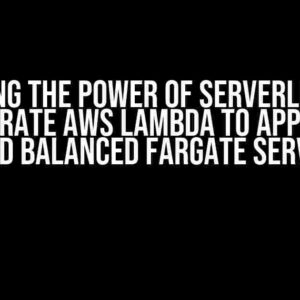Are you tired of scrambling to find S3 buckets without a policy in your AWS account? Well, put down that cup of coffee and take a deep breath, because today we’re going to tackle this problem head-on using the mighty AWS CLI!
What’s the Big Deal About Policies, Anyway?
Before we dive into the solution, let’s briefly discuss why policies are crucial for your S3 buckets. A bucket policy is a JSON document that defines the permissions, access controls, and access restrictions for your S3 bucket. It’s like a bouncer at a nightclub, deciding who gets in and what they can do once they’re inside.
Without a policy, your S3 bucket is like a public party – anyone can crash the bash and do as they please! This can lead to:
- Unintended data access or modification
- Data breaches and security risks
- Compliance issues and audit nightmares
Why Use AWS CLI?
AWS CLI is a powerful tool that allows you to manage your AWS resources from the command line. It’s like having a trusty sidekick that helps you automate tasks, simplify workflows, and extract valuable insights from your AWS account.
In this case, we’ll use AWS CLI to query for S3 buckets missing a policy, making it easier to identify and remediate security gaps in your account.
Prerequisites
Before we get started, make sure you have:
- AWS CLI installed and configured on your machine
- An AWS account with the necessary permissions to access and manage S3 buckets
- A basic understanding of AWS CLI commands and syntax
The Magic Command
Now, it’s time to reveal the magic command that will query for S3 buckets missing a policy:
aws s3api list-buckets --query 'Buckets[].{Name, PolicyStatus}' --output text | awk '$2 == "None" {print $1}'Let’s break it down:
aws s3api list-buckets: This command lists all S3 buckets in your account.--query 'Buckets[].{Name, PolicyStatus}': This query extracts the bucket name and policy status from the list of buckets.--output text: This option formats the output as plain text, making it easier to parse.awk '$2 == "None" {print $1}': This pipes the output to the AWK command, which filters the results to only include buckets with a policy status of “None” and prints the bucket name.
Interpreting the Results
Run the command, and you’ll get a list of S3 buckets missing a policy. The output will look something like this:
bucket-1
bucket-2
my-secure-bucket
...Take note of the buckets listed, as these are the ones that require a policy.
Creating a Policy for Your Buckets
Now that you’ve identified the buckets without a policy, it’s time to create one! You can use the AWS CLI to create a policy for each bucket:
aws s3api put-bucket-policy --bucket --policy file://policy.json Replace policy.json with the path to your policy file.
Example Policy
Here’s an example policy that allows only the bucket owner to access the bucket:
{
"Version": "2012-10-17",
"Statement": [
{
"Sid": "OnlyBucketOwner",
"Effect": "Deny",
"Principal": "*",
"Action": "s3:*",
"Resource": "arn:aws:s3:::",
"Condition": {
"StringNotEquals": {
"aws:PrincipalAccount": ""
}
}
}
]
} Replace
Tips and Variations
Here are some additional tips and variations to help you get the most out of this command:
- Use
--profileto specify a different AWS profile or credentials. - Add
--regionto specify a different region. - Use
aws s3api list-buckets --query 'Buckets[]|{Name}'to get a list of bucket names only. - Pipe the output to a file using
> output.txtfor further analysis or processing.
Conclusion
There you have it! With this magic command, you can easily query for S3 buckets missing a policy using the AWS CLI. Remember to create and apply policies to your buckets to ensure the security and integrity of your data.
Stay secure, and happy AWS-ing!
| Command | Description |
|---|---|
aws s3api list-buckets |
Lists all S3 buckets in your account. |
--query 'Buckets[].{Name, PolicyStatus}' |
Extracts the bucket name and policy status from the list of buckets. |
--output text |
Formats the output as plain text. |
awk '$2 == "None" {print $1}' |
Frequently Asked Question
Get ready to master the art of querying S3 buckets with AWS CLI!
How do I list all S3 buckets in my AWS account using AWS CLI?
You can use the following command: `aws s3api list-buckets –query ‘Buckets[].Name’`. This will return a list of all S3 bucket names in your AWS account.
What is the AWS CLI command to check if an S3 bucket has a policy attached?
You can use the following command: `aws s3api get-bucket-policy –bucket
How do I query for S3 buckets that are missing a policy using AWS CLI?
You can use the following command: `aws s3api list-buckets –query ‘Buckets[?!get(@, “policy“)]|[].Name’`. This will return a list of S3 bucket names that do not have a policy attached.
Can I use AWS CLI to add a policy to an S3 bucket that is missing one?
Yes, you can! Use the following command: `aws s3api put-bucket-policy –bucket
What are some best practices for managing S3 bucket policies?
Some best practices include: using least privilege access, defining policies at the bucket level, and regularly reviewing and updating policies to ensure they align with your security requirements.




